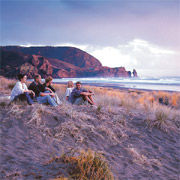Auckland’s West Coast Beaches - Day One
Auckland to Piha with a side trip to Whatipu

High in the foothills of the Waitakere Ranges the elevated township of Titirangi is reached via the North Western Motorway. We arrive ready to breakfast and follow our noses to the German café, Boss Konditorei, where fresh organic and wholegrain breads are baked daily. Its street appeal isn’t up to much and Bob screws up his nose, but once inside the views of the Manukau Harbour and selection of specialty cakes and breads win him over and he winds up telling its friendly owner, Ewald Boss that he intends to return for lunch.
Instead we purchase a selection of thick-cut sandwiches and pastries so we can picnic at our leisure, then visit the art gallery at Lopdell House where locals exhibit their work. As we leave Bob strikes up a conversation with a student-type with gorgeous long red locks. Her T-shirt states “Titirangi – it’s the west...but with a special flavour all its own. Titirangi is more than a village; it’s a way of living; it’s a feeling – it’s a state of mind.” She tells Bob to get out to Whatipu, “You won’t believe you’re in Auckland,” and departs to the local hairdressing salon, where all the products used are organic.
And so we take the road to Whatipu, past popular Cornwallis Beach with its ice cream and coffee caravan, the bottle-green horseshoe of Huia Bay and over the hills to Whatipu, nestled amongst the dunes.
The boom of the ocean can be heard from the car park and it becomes thunderous as we walk along a sandy pathway lined with colourful flowering grasses to the beach. Here surf pounds relentlessly against Paratutae Island which marks the northern head of the Manukau Harbour. It was the site of one of NZ’s most disastrous shipwrecks in 1863, when the HMS Orpheus ran aground at the cost of 189 lives.
I lead Bob along a rough unmarked route to the sea caves that were used in early days as shelter by local Maori, and later - in the 1920s - as a ballroom for timber workers. We pass Whatipu Lodge, built for the mill manager in 1867, and Liebergreen Cottage, a former mill workers cottage, thought to date from the 1860s.
We picnic amongst the dunes in swaying grasses watching the surf pound in. Bob reminisces about a surfing holiday he once had in Hawaii and how he was a dab hand on a Malibu board. As I watch him gobble pastries it’s pretty hard to imagine but I simply suggest that he hires a board and gives it a go.
There are no surfers at Whatipu today because the waves and currents are too dangerous, so we return to Titirangi and turn off onto Scenic Drive. It travels through the heart of the Waitakere Ranges which are cloaked in some 16,000 hectares of native rainforest, and feature waterfalls and several popular black sand surf beaches including Karekare, Piha, Bethells and Muriwai Beach.
The Arataki Visitor Centre is our next port of call, a good starting point for any exploration of this region. There’s a plant identification trail giving a good insight into local flora, and inside a range of displays outlines everything from the history of the region to short biographies on local artists. Bob spends quite some time admiring the sweeping views of Nihotapu Dam and Manukau Harbour from its back decks.
A huge volcano formed the Waitakere Ranges over 20 million years ago, and today we can still see many large kauri, rimu and kahikatea trees. Kauri was logged here in the early 1800s and there are several tramways in the bush that were originally used for the logging industry. Later they provided access for workers to construct dams and water pipes. It was also used to transport sightseers aboard Watercare’s Rainforest Express to view the Upper Nihotupu Dam, until this service was stopped in late 2014 for safety reasons.
As we continue along Scenic Drive there are numbers of points offering panoramic views of Auckland Harbour Bridge, the Sky Tower and beyond to Rangitoto and Waiheke Island. We stop several times before turning off to Piha and checking into our accommodation, an original Kiwi bach (holiday home) overlooking the water.
It’s late afternoon and as the sun drops in the sky, Bob decides to try his hand surfcasting using a rod from the bach. “I’ll be back soon with fish,” he calls out as I leave, shaking my head, to pick up supplies from the Piha Store.
Outside I meet a man on the verandah painting a picture of Lion Rock, a massive island-like rock which sprouts from the middle of the beach. We chat for a while and it’s almost dark by the time I return to our abode armed with breakfast supplies, fresh bread and a can of baked beans for dinner.
"Oh ye of little faith," says Bob later on as he fries a decent sized snapper which we eat seated upon deck chairs on the verandah and watch the sun set.